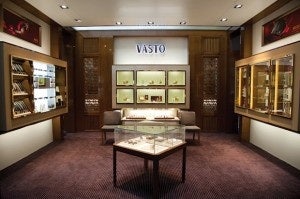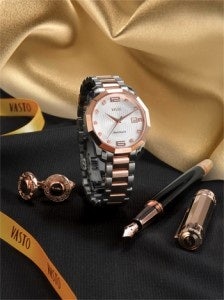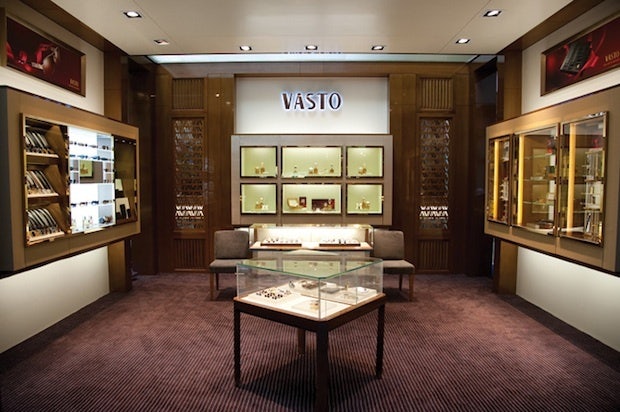"Some Of The Swatch Brands [Are Already] In Fourth Tier Areas"#

Still-booming growth in China's luxury market, which has it on track to surpass Japan as the world's top spender on high-end goods by 2015, has seen major brands continue to invest in nationwide expansion, but issues such as a shortage of suitable retail space have made some question whether the market is seeing early signs of saturation. Despite these concerns, on-the-ground statistics indicate that, while the market is evolving and the consumer is becoming gradually more sophisticated, demand remains high. According to CNN, LVMH's first-quarter sales jumped 25 percent this year, "thanks to China," adding, "While Chinese buyers are Louis Vuitton's biggest customers already, the market is far from saturated." As Wendy Trevisani, a portfolio manager at Thornburg Investment Management, put it, "China's consumer is still in its infancy," and consumer spending is growing "pretty much without hesitation."
This week, IW Magazine speaks to Swiss watch veteran Marc Bernhardt, who now works for the Chinese luxury group VASTO, who, like Trevisani, feels that the vastness of China's interior -- and the potential of consumers in third- and fourth-tier cities far from Beijing or Shanghai -- means the market remains one of the most enticing in the world. VASTO, which currently operates around 300 points of sale throughout China, as well as shops in Switzerland and the Middle East and plans to expand to France and the US, positions itself as the "Brooks Brothers of China," sells apparel, Swiss-made watches, French-made pens and Italian leather goods. From Bernhardt's interview:
IW: Tell us about the Chinese luxury market.
Marc Bernhardt (MB)
: China is a huge country with a population of 1.4 billion, but is made up of made very different markets of which differences may be as large as exist between Scandinavia and Italy. However, the “standardization” as evidenced by similar looking malls with uniform global brand marketing campaigns is leveling the playing fields. Based on the development and penetration (of international) brands, the market is largely divided into first, second, third and even fourth tier areas. First tier markets include Shanghai, Beijing and Guangzhou, which have modern infrastructure and a Westernized consumer. Other tier cities will include cities with a population of around 1 million each. Western brands usually enter China through tier one and two and then work their way down.
It is amazing to already see particularly the presence of some of the Swatch brands (Tissot, Rado, Longines) in fourth tier areas. So the notion that there is still virgin territory with ignorant consumers can slowly be dismissed.
IW: So are you saying that China is reaching saturation for luxury products?
MB
: No, on the contrary! There is still plenty of potential and it is forecasted that two-thirds of future wealth creation will particularly take place in tier three and four areas. What I mean to say is that consumers are becoming much more knowledgeable and you have to have a credible brand and story to tell. To a large extent this is the problem that many Chinese “luxury” brands are facing—and there are many of them, from garments to luxury furniture. Many have been free-riding with adopted European sounding names or blatant copies of existing international brands—some of the examples with derivatives of Gucci, Dior or Boss are almost funny and should keep trademark lawyers very busy.
IW: But what is the quality like of these Chinese luxury brands?
MB
: Well, some of it is really quite good reaching similar levels as international brands. Actually, you would be surprised to see the high prices, but we can touch on this subject when we talk about the consumers. Again, many international brands already produce many of their items in China, so a certain know-how and savoir faire is present in the Chinese manufacturing base. What Chinese brands lack is instilling a story, a meaning and raison d’être in their products. In the past it was sufficient to pretend to be European, preferably with a blond and blue-eyed model advertising the product. Today, this marketing strategy is passé. Consumers are asking questions and are generally more critical than in the past. Recently, there was a widely publicized scandal involving a luxury furniture maker that was selling high priced “Italian Made Furniture” that turned out to be low-end Chinese-made—the company needed police protection to fend off angry consumers.
IW: Tell us about the Chinese Consumer. What distinguishes them from American or European consumers?
MB
: For many years, China has been the origin of mass-produced goods often at the lower quality end. So perhaps, the impression may be that Chinese consumers having grown up in this environment will not be as demanding as their Western counterparts. This is totally false! I have rarely seen more demanding and finicky consumers. Visitors to Hong Kong may have already observed expensive watches in the shop window wrapped in protective cling film. A Chinese buyer will literally take out a magnifying glass to ascertain that there are no marks of use. Due to the propensity of fakes (from products to bank notes) Chinese are particularly careful. Anecdotally, this is also the reason why in restaurants a chicken (or any other meat dish) will often be served with the head to prove the genuine product.
On one hand, Chinese consumers will try to achieve a maximum discount, which is the reason why prices are often marked double the suggested price. On the other hand, things cannot be marked too cheap, as this would again raise suspicion that the quality was inferior or that the product may be fake. So setting the right price is a big challenge.
In general, Chinese are much more “suspicious” about the quality and serviceability of a product. For this reason, it is important to have a visible after-sales-service, an area where for instance Tissot leads with a technician work bench at each Tissot point of sale.

Though the importance of second-, third- and now fourth-tier cities to the continued development of China's luxury market, and the increasing connoisseurship of first-tier consumers and luxury "veterans," isn't exactly new, major takeaways from this interview for luxury brands include more of an emphasis on legitimate story and making it personal to the Chinese consumer (rather than just pushing a clichéd "European" identity), a greater and more visible after-sales service infrastructure, and high-tech anti-counterfeiting efforts to reassure shoppers.
